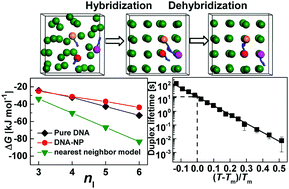当前位置:
X-MOL 学术
›
Soft Matter
›
论文详情
Our official English website, www.x-mol.net, welcomes your feedback! (Note: you will need to create a separate account there.)
Significance of DNA bond strength in programmable nanoparticle thermodynamics and dynamics†
Soft Matter ( IF 3.4 ) Pub Date : 2018-02-26 00:00:00 , DOI: 10.1039/c7sm02456h Qiuyan Yu 1, 2, 3, 4, 5 , Jinglei Hu 5, 6, 7, 8 , Yi Hu 1, 2, 3, 4, 5 , Rong Wang 1, 2, 3, 4, 5
Soft Matter ( IF 3.4 ) Pub Date : 2018-02-26 00:00:00 , DOI: 10.1039/c7sm02456h Qiuyan Yu 1, 2, 3, 4, 5 , Jinglei Hu 5, 6, 7, 8 , Yi Hu 1, 2, 3, 4, 5 , Rong Wang 1, 2, 3, 4, 5
Affiliation

|
Assembly of nanoparticles (NPs) coated with complementary DNA strands leads to novel crystals with nanosized basic units rather than classic atoms, ions or molecules. The assembly process is mediated by hybridization of DNA via specific base pairing interaction, and is kinetically linked to the disassociation of DNA duplexes. DNA-level physiochemical quantities, both thermodynamic and kinetic, are key to understanding this process and essential for the design of DNA-NP crystals. The melting transition properties are helpful to judge the thermostability and sensitivity of relative DNA probes or other applications. Three different cases are investigated by changing the linker length and the spacer length on which the melting properties depend using the molecular dynamics method. Melting temperature is determined by sigmoidal melting curves based on hybridization percentage versus temperature and the Lindemann melting rule simultaneously. We provide a computational strategy based on a coarse-grained model to estimate the hybridization enthalpy, entropy and free energy from percentages of hybridizations which are readily accessible in experiments. Importantly, the lifetime of DNA bond dehybridization based on temperature and the activation energy depending on DNA bond strength are also calculated. The simulation results are in good agreement with the theoretical analysis and the present experimental data. Our study provides a good strategy to predict the melting temperature which is important for the DNA-directed nanoparticle system, and bridges the dynamics and thermodynamics of DNA-directed nanoparticle systems by estimating the equilibrium constant from the hybridization of DNA bonds quantitatively.
中文翻译:

DNA键强度在可编程纳米粒子热力学和动力学中的意义†
涂有互补DNA链的纳米颗粒(NPs)的组装会导致形成具有纳米级基本单位而不是经典原子,离子或分子的新型晶体。组装过程是通过DNA杂交介导的经由特异性碱基配对相互作用,并且在动力学上与DNA双链体的解离有关。DNA水平的物理化学量(包括热力学和动力学)是理解此过程的关键,对于DNA-NP晶体的设计至关重要。熔解转变特性有助于判断相关DNA探针或其他应用的热稳定性和敏感性。使用分子动力学方法,通过改变连接子长度和间隔子长度来研究三种不同的情况,连接子长度和间隔子长度决定了其熔融性能。熔解温度通过基于杂交百分数与温度和林德曼熔化定律同时发生。我们提供了一种基于粗粒度模型的计算策略,可根据实验中容易获得的杂交百分比估算杂交焓,熵和自由能。重要地,还计算了基于温度的DNA键脱氢的寿命和取决于DNA键强度的活化能。仿真结果与理论分析和实验数据吻合良好。我们的研究提供了一个很好的策略来预测对DNA定向纳米颗粒系统重要的熔化温度,并通过定量估计DNA键杂交的平衡常数来桥接DNA定向纳米颗粒系统的动力学和热力学。
更新日期:2018-02-26
中文翻译:

DNA键强度在可编程纳米粒子热力学和动力学中的意义†
涂有互补DNA链的纳米颗粒(NPs)的组装会导致形成具有纳米级基本单位而不是经典原子,离子或分子的新型晶体。组装过程是通过DNA杂交介导的经由特异性碱基配对相互作用,并且在动力学上与DNA双链体的解离有关。DNA水平的物理化学量(包括热力学和动力学)是理解此过程的关键,对于DNA-NP晶体的设计至关重要。熔解转变特性有助于判断相关DNA探针或其他应用的热稳定性和敏感性。使用分子动力学方法,通过改变连接子长度和间隔子长度来研究三种不同的情况,连接子长度和间隔子长度决定了其熔融性能。熔解温度通过基于杂交百分数与温度和林德曼熔化定律同时发生。我们提供了一种基于粗粒度模型的计算策略,可根据实验中容易获得的杂交百分比估算杂交焓,熵和自由能。重要地,还计算了基于温度的DNA键脱氢的寿命和取决于DNA键强度的活化能。仿真结果与理论分析和实验数据吻合良好。我们的研究提供了一个很好的策略来预测对DNA定向纳米颗粒系统重要的熔化温度,并通过定量估计DNA键杂交的平衡常数来桥接DNA定向纳米颗粒系统的动力学和热力学。


























 京公网安备 11010802027423号
京公网安备 11010802027423号